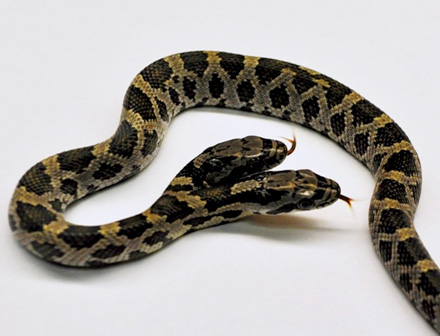John Miller has an interesting question about the newest resident of the Missouri Department of Conservation’s (MDC) Shepherd of the Hills Hatchery Conservation Center: Is a two-headed snake referred to as “it” or “they?”
It’s one of many questions visitors will have about the young western ratsnake that has been put on display in the auditorium of the hatchery’s Conservation Center. Shepherd of the Hills Hatchery is known for producing trout but in terms of public interest, the thousands of rainbows housed at the hatchery may have to take a temporary backseat to one very unique-looking reptile.
“This is extremely rare,” said Miller, MDC’s Interpretive Center Manager at the Hatchery. “In my 30 years of working with snakes, this is the first time I, personally, have seen one come from the wild.”
A curious teenager, Terry Lowery, found the snake last October under the deck of his family’s home in Hurley in Stone County. After taking a photo and doing some on-line research, the Lowerys learned that the unique-looking snake was a non-venomous western ratsnake. The Lowerys contacted the Dickerson Park Zoo in Springfield and zoo staff contacted Miller at the Hatchery. The Lowery family requested, if possible, that the snake be displayed to the public. Before putting the snake on public display, MDC staff wanted to observe the snake for a period of time to assess its health. Since coming to the hatchery, the snake has shed twice, both heads are eating and all external functions appear to be fine.
“Aside from its two heads, it is essentially one snake,” Miller said. “From the esophagus down, it has all the organs a normal snake would have. My biggest concern was if each esophagus was connected to the same digestive system. I was relieved when, after having each head swallow a tiny mouse, two lumps appeared in the stomach.
“Because each head shares a common body, it will be one gender,” Miller said. “My next observation will be to determine if it’s a male or female.”
Western ratsnakes – also known as black ratsnakes – are common throughout Missouri. Since this one is still in its juvenile stage, the snake has a spotted pattern. As it matures, it will become the coloration that most people associate with this familiar snake – a bluish-black back with a white underbelly.
Polycephaly – the condition of having more than one head – is extremely rare throughout the animal kingdom, but occurs more frequently in snakes than in other animals. In most documented cases, two-headed snakes have lived only a few months, but there have been instances where they have lived full lives in captivity and even reproduced.
“This is similar to Siamese twins in which a developing embryo inside the egg does not fully divide into identical twins and, thus, the twins are joined,” said MDC State Herpetologist Jeff Briggler. “In over 17 years in Missouri, I have seen four two-headed snakes and two two-headed turtles.”
A two-headed western ratsnake that was found in 2005 is currently on display at the Missouri Department of Conservation’s Cape Girardeau Conservation Nature Center in southeast Missouri.
Briggler said that a two-headed snake would have a decreased chance of surviving in the wild for a variety of reasons. It would be extremely vulnerable to predation because it wouldn’t have the ability to escape down the normal holes and crevices that one-headed snakes can fit into. Also, foraging and feeding could be difficult due to two heads acting independently of each other.
However, in a captive situation where it’s able to be cared for and observed, this snake can provide valuable insight about this unique condition. Besides the research value, visitors have a chance to see a very unique snake.
“We welcome everyone to come to the Shepherd of the Hills Hatchery Conservation Center to see and photograph the snake,” Miller said. “It goes without saying that you’ll rarely ever see anything like this. People are also welcome to make their own guesses as to whether the snake is male or female.”

TWICE THE BITE – This two-headed western ratsnake found last fall in Stone County is currently on display at the Missouri Department of Conservation’s Shepherd of the Hills Hatchery in Branson.
Since being found last fall in Stone County, this two-headed western ratsnake has shed twice, is eating regularly and appears to have all the normal functions of a regular snake.



Facebook Comments